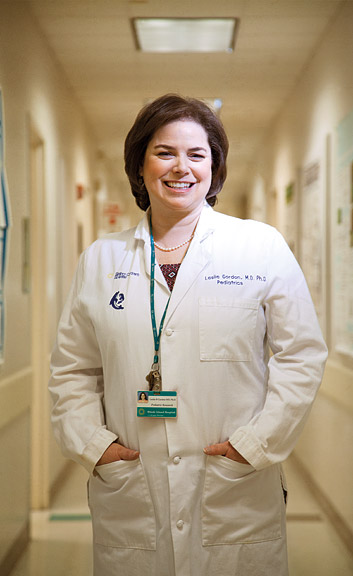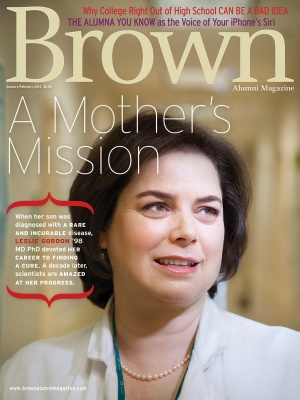When Sam Berns was nine months old, his parents noticed that his growth had slowed. A short time later, Sam began to lose his hair, and his teething was delayed. Although both of Sam’s parents, Leslie Gordon ’98 MD PhD, and Scott Berns, are medical doctors, they were unable to make a diagnosis; nor could the specialists whom they consulted. Finally, in Sam’s second year, Monica Kleinman ’84, ’87 MD, a family friend who is a pediatric intensive care physician at Boston Children’s Hospital, suggested that Sam might have progeria, a very rare—and fatal—disease of childhood.

Although no one could have known it at the time, Sam’s diagnosis would soon transform our knowledge of this terrible disease. The cluster of symptoms that would become known as progeria was first described in 1886 by the English physician and surgeon Jonathan Hutchinson. Eleven years later, in 1897, another English surgeon, Hastings Gilford, suggested naming the disease progeria, derived from the Greek words pro (before) and geras (old age). Its official name became Hutchinson-Gilford progeria syndrome.
Progeria occurs in only one of four million to eight million children. By the time they are a few years old, children with progeria bear an uncanny resemblance to one another. They are short in stature, and their skulls are large and bald, with prominent veins. They resemble old people in a number of ways: the mobility of their joints is compromised; their bones are thin; and they lose not only their hair but the fat deposits under their skin. In just a few short years—often between the ages of six and eight—these children develop cardiovascular disease symptoms. Strokes have been reported as early as age four. Eventually, progeria children’s premature atherosclerosis leads to a fatal heart attack or stroke at an average age of fourteen.
Although the children look like small old people in many ways, they do not develop all the characteristics of an aging adult. Fortunately, their mental powers are unaffected. Their intellects and personalities are appropriate to their age. Children with progeria are often remarkably alert, active, and cheerful. Many successfully attend public schools.
The night Leslie Gordon learned of Sam’s diagnosis, she stayed awake
grieving and pondering what to do. Shortly before he’d been diagnosed,
at twenty-two months, Leslie had begun her residency in pediatric
ophthalmology at Hasbro Children’s Hospital in Providence and at the
Massachusetts Eye and Ear Infirmary in Boston. She soon decided to
resign her residency and focus her research on finding a treatment and
cure for progeria.
One day in the fall of 1999, when Sam was three years old, I received a
phone call from Paul Knopf, a professor of medical science at Brown.
Knopf had codirected Leslie’s Ph.D. thesis and was advising her on
entering the field of progeria research. I had taught courses in the
biology of aging at Brown, so Knopf called to ask me to send Leslie
references on progeria and the aspects of aging related to it.
I gladly obliged and soon joined a small group of researchers who met periodically with Leslie to help her gain mastery of her new field and to identify a promising line of research. Leslie affectionately dubbed us her “Brainstormers.”
Before my first meeting with Leslie, I tried to put myself in her shoes. As a research scientist, I had sometimes stayed at my laboratory far into the night, driven by the excitement and demands of research. Now I tried to imagine what it would be like for Leslie: tired in the lab, more than ready to call it a night, but pushing even harder in the belief that the life of her child might depend on the extent of her effort. Did this recently minted physician-scientist realize what she was getting into?
What I saw when Leslie arrived at my first meeting with the Brainstormers was a cheerful young woman, slightly breathless from having completed the arduous task of finding a parking place near the Brown campus. She arrived bearing gifts of doughnuts and coffee. After introductions we got to work, and during a break I found myself alone with her. I thought that as a stranger I might find it easier than some of the others to broach the subject of the enormous emotional difficulties she might face while doing what she was setting out to do. She responded without hesitation and calmly told me, “I know I may not succeed in saving Sam’s life, but I could not live with myself if I didn’t try.”

The term gene was coined early in the twentieth century to describe the functional units of heredity that pass from generation to generation. By the middle of the century, we knew that genes are chemically composed of DNA (deoxyribonucleic acid), which in turn consists of four types of chemical subunits, called nucleotides, strung together in very long linear arrays. A gene is typically composed of tens of thousands of nucleotides arranged in a specific sequence. Genetic information is coded in that sequence of nucleotides, just as the sound of a tune is coded in the sequence of its musical tones. Mutations cause changes in the nucleotide sequence, thereby affecting the function of the gene. Just as changing a tone in a song usually messes up the melody, a mutation usually messes up how a gene functions.
There are about 25,000 genes in the human genome. By 1999 the results of the Human Genome Project had greatly facilitated their identification. The task for progeria research, therefore, looked formidable but not impossible. But finding the gene for progeria presented some unusual obstacles. One was that the standard method used for locating a gene could not be used. That method involved examining the patterns of inheritance of the disease over several generations. But in progeria families neither parents nor siblings of the afflicted children have the disease, and the progeria patients do not live long enough to have children of their own.
A second obstacle at the time was a complete absence of research funding. Even the Office of Rare Diseases at the National Institutes of Health (NIH) had not paid attention to a disease so rare that at any one time there may be only a couple of hundred cases in the world. One possible way to attract funding was to consider progeria a useful model for normal aging or heart disease. However, the National Institute on Aging (NIA) did not consider progeria a useful model for aging.
To overcome this lack of support, Sam’s family founded the Progeria Research Foundation (PRF), whose mission is to find treatments and a cure for progeria. Leslie’s sister, Audrey Gordon, Esq., became PRF’s president and executive director; Leslie became its medical director; and Sam’s father, Scott Berns, chaired the board of directors, which, among others, included Brown colleagues, Rabbi Harold Kushner (author of the best-selling book When Bad Things Happen to Good People), and Suzette Kushner, his wife. The Kushners’ son had died from progeria at age fourteen.
Much of the PRF’s early work was carried out by volunteers or by professionals working pro bono. Funds raised in the first two years included gifts from individuals and from sponsors of such local events as festival booths and benefit concerts. In 2001 the PRF initiated a biennial silent auction series that has raised substantial funds over the years. Gifts from private foundations and corporations have also increased.
Leslie wanted to involve the families of children with progeria, most of whom lived far from one another and were isolated in their struggle. The PRF set up a website to provide frequently updated information and treatment strategies. Leslie also made herself available by telephone and e-mail.
Meanwhile, Leslie continued to meet with the Brainstormers. In 2000 she formulated a research project and was awarded a three-year American Heart Association Scientist Development Grant of $240,000.
While thinking about progeria, I formulated a method of isolating the gene. I had not kept up with the rapid advances in molecular biology during my years as Brown’s provost from 1990 to 1995, and I had also closed my lab. I needed a collaborator. I approached Professor of Medical Science John Sedivy, who was studying the biology of aging cells in his state-of-the-art molecular biology laboratory. At first he was hesitant to add a new direction to his research, but, after meeting with Leslie, Sedivy agreed to develop my idea into a research proposal. “Leslie is a very compelling person,” he told me.
Although the initial years of fund-raising had helped start up progeria research in a few labs, much more money would be needed for the robust research the PRF was planning. It hoped to develop an extensive grant award program, a medical database, a cell-and-tissue bank, and periodic workshops with scientists and physicians to facilitate the exchange of information.
Winning the support of the National Institutes of Health (NIH), the largest source of biomedical research funding in the United States, became a major goal. An exceptional opportunity arose in 2000, when Congress amended the Public Health Service Act to broaden support of research on children’s health. Lobbying by PRF leaders and Rabbi Kushner’s testimony at a Congressional hearing led to progeria’s being specifically named in the Children’s Health Act of 2000 as one of two rare children’s diseases for which the NIH director assumed some oversight.
It was about this time that Scott and Leslie met Francis Collins,
then the director of the National Human Genome Research Institute and
now the director of the NIH. One of the most influential geneticists in
the United States, Collins had led one of the two teams that had
unraveled the entire sequence of the human genome. Years before, during
his medical training, he had seen a child with a disease that closely
resembled progeria, and the absence of any treatment for this child had
made a lasting impression on him. Now that the genome sequencing was
completed, he was looking for ways to apply this new knowledge to the
treatment and cure of diseases. After meeting Leslie, Scott, and Sam,
Collins began working on finding the progeria gene.
Another important contact was Huber Warner, director of biology and
aging at the National Institute on Aging. Leslie persuaded him of the
relevance of progeria to the study of aging, and he agreed to have the
NIA cosponsor a workshop on progeria with the PRF. Collins agreed to
discuss his research plans at the PRF workshop in Bethesda, Maryland,
scheduled for November 28 and 29, 2001. As I worked with Leslie on
drafting the workshop agenda, we realized that there was not enough
ongoing research on progeria to fill even a one-day meeting. But Leslie
had a novel idea. She invited experts in the organ systems most
affected by progeria—cardiovascular, bone, extracellular matrix, and
skin—to speak. She sent each speaker the published articles that best
described the changes brought on by progeria in the organs and tissues
of his or her expertise, and she asked them to present any clues about
progeria that they had gleaned from the articles.
Forty-six physicians and scientists assembled at this unusual and historic meeting. Reports on bone and on the cardiovascular system identified differences at the organ level between progeria and normal aging. But the workshop session that had the greatest impact on moving progeria research forward was a panel discussion on identifying the progeria gene. The laboratories of Collins, Sedivy, and the University of Michigan’s Tom Glover had begun to search for the progeria gene, each using a different strategy. Ted Brown announced he had observed that cells from one progeria patient with an extreme phenotype showed a large aberration in the structure of chromosome 1, one of the forty-six human chromosomes. This aberration was not found in any other children with progeria, but it might be a clue. Limiting the search to the DNA on chromosome 1 would greatly simplify the search for the progeria gene.

Six months later, during a consortium conference call, the discussion centered on a chromosome region of about forty genes, where Ted Brown had found the abnormality in his one patient. Within six more months, Collins, his postdoctoral fellow Maria Eriksson, and collaborators from five consortium laboratories identified the mutated gene and its exact location. The DNA of the mutant differed from normal DNA by a change in only one nucleotide out of the sequence of 25,373 nucleotides that constitute the gene. The results were published in the May 15, 2003, issue of Nature. Only three years had passed since the creation of PRF.
Progeria research had run into a major stroke of luck: the progeria mutation alters a gene whose functions were already well known. The gene, LMNA, codes for the protein lamin A, a major component of a network of proteins that lines the inner surface of the nucleus. Lamin A was already known to function in a variety of crucial cellular processes whose disruption could account for many of the devastating changes progeria causes.
The discovery that progeria cells produce an altered lamin A catapulted progeria research into mainstream studies in cell biology and biochemistry. Several cell biologists who were already studying lamin A expanded their studies to include progeria. The cell lines and patient information that the PRF supplied proved invaluable. From 1950 through 2002 an average of two publications about Hutchinson-Gilford progeria appeared per year; from 2003 through 2007 that number multiplied more than tenfold to an average of twenty-one a year. (By 2012 that number was sixty-four.)
What’s more, the particular chemical change in the structure of the
altered lamin A immediately suggested a class of drugs for treating the
disease. During the synthesis of normal lamin A, a lipid group called
farnesyl is attached at one end of the molecule. In normal cells, when
the farnesylated molecule moves from the cytoplasm (where it is made)
to the nucleus (where it is destined to function), the farnesyl group
is cleaved off. But due to the changes in lamin A caused by the
progeria mutation, the farnesyl group is not cleaved off. The
continuing presence of this lipid at the nuclear membrane could account
for the many changes caused by progeria. Drugs called
farnesyltransferase inhibitors (FTIs), which prevent attachment of
farnesyl groups to proteins, were available and had already been found
to be safe when used in children for the treatment of some cancers.
Before a clinical trial of FTIs for progeria could be proposed,
however, we had to establish the efficacy of the drug in treating the
disease in the laboratory. In 2004, several research groups
independently found that the nuclei of progeria cells became normal
when they were grown with FTI added to the culture medium, proving that
the drug worked at the cellular level.
But extrapolating cultured cells to those in a living human is a huge jump. Fortunately, in this age of genetic engineering, it is possible to examine the effects of a drug on a “model” mouse into which a gene for a human disease had been introduced. A model progeria mouse displayed some characteristics of progeria, including decreased life span and diminished weight gain. Treatment with lonafarnib, an FTI, reduced these symptoms.
The time had come to prepare a clinical trial. Many such trials involve hundreds or thousands of patients divided into an experimental group, which receives the drug, and a control group, which is given an innocuous material instead. The two groups are matched for age, gender, and other pertinent characteristics, and the results of the treatment are analyzed as the difference between the two groups.
However, the number of children available for a progeria clinical trial was fewer than thirty, too small a sample for generating robust statistical analysis of the data collected. More importantly, some of the children in the control group were likely to die from the disease during the course of a two-year trial. Therefore, an “open-label” trial, in which all the children receive the drug, was proposed.
Clinical markers in the patients were measured for a year before the trial, and to prove that a drug is having an effect, the investigators would extrapolate this data to predict what the values of the clinical markers would be without drug treatment over the course of the trial. Then the results obtained in the treated patients would be compared with these predictions to determine whether the drug is having an effect.
In June 2006, after receiving expert opinions, the PRF medical research committee and board of directors chose an open-label-trial proposal submitted by Boston Children’s Hospital in collaboration with the Dana Farber Cancer Institute. The principal investigator, Mark Kieran, had directed many FTI-based clinical trials in which the patients were children. Both Leslie and Boston Children’s Hospital’s Monica Kleinman served as cochairs. The twenty-eight children enrolled in the trial were between three and sixteen years old, lived in sixteen countries, and among them spoke fourteen languages. The PRF and Children’s Hospital arranged for translators to be with the families during their hospital visits.
The two-year trial began in May 2007, only five years after the progeria gene had been identified—a record time for a genetic disease. The children, accompanied by their parents, were admitted to Boston Children’s Hospital two at a time for a round of tests and initiation of treatment, and then returned home with the experimental drug lonafarnib. Children and their parents returned to Boston Children’s Hospital every four months for tests. The PRF provided the $2 million needed to pay for the trial, including the families’ travel.
While the stage was being set for the clinical trial, the basic science underlying progeria and its relation to aging and heart disease continued to be vigorously investigated. The mutant form of lamin A found in progeria is present in skin cells of people not affected by the disease and accumulates with age. Experiments have confirmed the similarity of some biochemical and physiological changes triggered by progeria to changes that take place in normal aging. Today, it is generally accepted that progeria is a valid model for some of the processes that result in normal aging. The discovery of a possible role for lamin A in the aging process of each of us had occurred as a result of exploring one of the rarest diseases on earth.
The results of the progeria clinical trial were published in 2012 in the Proceedings of the National Academy of Sciences.
Treatment with lonafarnib yielded improvements in weight gain, vascular
stiffness, and bone structure in some patients, and provided evidence
for decreased headaches and strokes. However, the extent of
improvements varied among patients. The decrease in the stiffness of
blood vessels was particularly significant. Arterial stiffness normally
increases with age, but during the course of drug treatment the
stiffness declined from that in normally aging people sixty to
sixty-nine years old to that typical of forty- to forty-nine-year olds.
Children with progeria die of heart attacks or stroke; therefore,
targeting their blood vessels might turn out to help extend their
lives, though it was too early to see survival changes at that time.
Sam was ten years old when he was enrolled in the trial in the spring
of 2007. Around that time, I was invited to a cookout at his home and
jotted down my impressions of him. He was having a fine time, horsing
around with his friends at the pool, and playing some challenging video
games. He knows of the prominent role that his mother has played in
fighting the disease that has affected him since he can remember, and
takes in stride his derivative role as a public face of progeria.
Mother and son are very close. Leslie’s enormous determination and energy have allowed her to meet the more than full-time demands of the difficult career path she has chosen without affecting the love and attention she bestows on him. On most school days her work is suspended between three-thirty in the afternoon, when she goes to meet Sam’s school bus, and nine-thirty in the evening, when she has settled him in bed. Then it’s back to work.
Sam is now seventeen. He has come to believe that having progeria is not his whole identity, but just one component of it. His life shows this. He is an outstanding student in a public high school, where he is a drummer in the marching band. He has become an Eagle Scout, having completed the rigorous requirements for this top rank. Among numerous recreational activities, he is also an avid sports fan. His sense of humor is illustrated by his comment (with a smile) that he “would like to become an inventor, kind of like Einstein and Steve Jobs combined.”
Looking back over the last ten years, Leslie Gordon tells me, “The rapid progress in progeria research over the past ten years suggests a roadmap for how to optimize our chances of tackling a disease once its molecular basis is uncovered. A key element to success has been a strong basic research foundation that creates detailed knowledge of the fundamental cellular disease process. Equally important has been access to patients and intense and regular communication between basic and clinical investigators, in this case through intensive work by PRF.”
Update: This article was completed on December 13, 2013. Sam Berns passed away on January 10, due to complications from progeria.
Frank G. Rothman, former provost and professor of biology at Brown,
has been associated with Leslie Gordon and the Progeria Research
Foundation for the past fourteen years.




